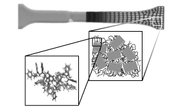
Content
During the design of a product, it is crucial to know where, when, and how a material fails. You can think of applications in automotive engineering (energy absorption in crash), energy (failure behavior of wind turbine blades, batteries), microsystems (flexible electronics), biomedical engineering (prostheses, in-body devices) , and safety (laminated and / or bulletproof glass), but also lifetime predictions of load and load-bearing structures.
In order to quantitatively describe failure behavior, we make use of computer simulations. This course mainly focuses on the two most relevant aspects. First you learn how plastic deformation is implemented in 3D macroscopic (continuum) material models (in essence a continuation of what you have learned, in 1D, during the course Solid Mechanics). The second aspect concerns the multi-scale modeling of materials, aiming at the coupling of macroscopic behavior to processes that occur in the microstructure. You will realize that understanding and quantifying these underlying processes explains where, when and how a material, on the macroscopic level, fails plastically.
- Discuss phenomena that go beyond elasticity.
- Illustrate viscoplastic behavior in solid plastics and metals.
- Expand macroscopic elastic models to include viscoplasticity.
- Explain that microstructure is responsible for the viscoplastic response.
- Introduce a systematic framework for designing multiscale models.
- Apply this framework to concrete 2-scale (micro and macro) models to describe the viscoplastic response of solid plastics and metals.
- Implement and perform numerical simulations in order to gain experience with real problems.
- Visit a company conducting material research
Learning objectives
- Add viscoplasticity to elastic models.
- Identify the relevant microstructural processes of existing materials that are responsible for viscoplastic behavior.
- Link microstructure to the continuum with a modeling framework.
- Apply this framework on the mechanical behavior of solid plastics and metals
Contact
-
Ties Kuitmr. Dirk Verbeek MPhilvan de Vendreef7722LG Alphen
-
Elena MangalFiene van Kuijc van MalsenLelijveldsteeg4382JC Ouwster-Nijega